Publications Laser diagnostics Engine research Flame spectroscopy Astronomy & Atmospheric optics TI-58/59 Contact Home
![]()
Click on any image for a larger version.
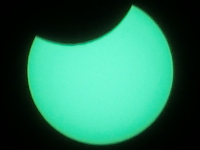 Partial solar eclipse 2021, photographed near Groningen through a dark green welder's glass
Partial solar eclipse 2021, photographed near Groningen through a dark green welder's glass
 Comet NEOWISE (C/2020 F3) above Groningen in the summer of 2020
Comet NEOWISE (C/2020 F3) above Groningen in the summer of 2020
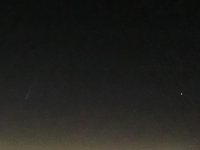 Comet NEOWISE (below centre of large image). Upper left shows part of the constellation Ursa Major ("Big Dipper"), the star Capella (α Aurigae) is clearly visible in the lower right.
Comet NEOWISE (below centre of large image). Upper left shows part of the constellation Ursa Major ("Big Dipper"), the star Capella (α Aurigae) is clearly visible in the lower right.
The 9 February 1990 total lunar eclipse. Each image has been exposed multiple times (scans of photographs of slides).
 Start of slight haziness - end of eclipse
Start of slight haziness - end of eclipse
![]()
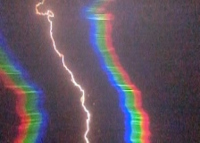 Spectrum of lightning, photographed with a diffraction grating (600 lines/mm) in front of the camera lens.
Spectrum of lightning, photographed with a diffraction grating (600 lines/mm) in front of the camera lens.
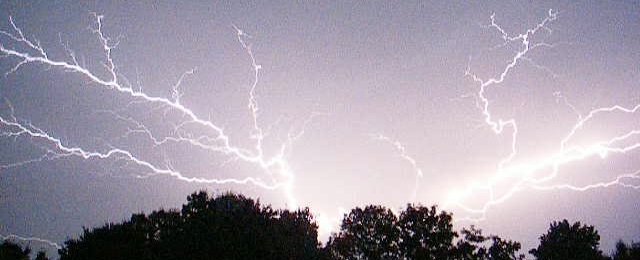
Still photographs from a movie recorded during a summer's night lightning display. Click on the still photographs to see all frames, the full movie is available below. The camera records at 30 frames per second and is equipped with automatic exposure adjustment, which can be noticed in the movie.
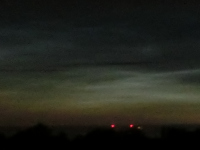 Noctilucent cloud display above Groningen in the summer of 2020.
Noctilucent cloud display above Groningen in the summer of 2020.
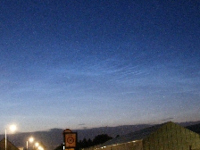 A nice display of noctilucent clouds on 12 July 2009, around 23:19 local
time (the first I ever observed; from Gelderland, The Netherlands). The
display lasted more than half an hour. The exposure time of 2 seconds
(on a digital compact camera) makes the scene look brighter than it
really was. The star Capella (α Aurigae) is clearly visible
above the left greenhouse.
A nice display of noctilucent clouds on 12 July 2009, around 23:19 local
time (the first I ever observed; from Gelderland, The Netherlands). The
display lasted more than half an hour. The exposure time of 2 seconds
(on a digital compact camera) makes the scene look brighter than it
really was. The star Capella (α Aurigae) is clearly visible
above the left greenhouse.
![]()
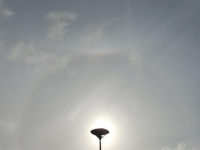 Well developed 22 degree halo around the sun. The left parhelion ("sun dog") is visible, but the right parhelion is absent. Also visible are the upper tangent arc (cusp like structure touching the 22 degree halo) and the supralateral arc, overlapping with part of the circumzenithal arc (bright colourfull patch near the top of the image).
Well developed 22 degree halo around the sun. The left parhelion ("sun dog") is visible, but the right parhelion is absent. Also visible are the upper tangent arc (cusp like structure touching the 22 degree halo) and the supralateral arc, overlapping with part of the circumzenithal arc (bright colourfull patch near the top of the image).
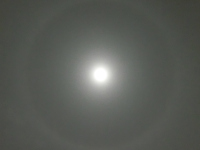 An almost complete 22 degree halo around the full moon (which itself is overexposed). A bright star is visible to the upper right of the moon, outside the halo.
An almost complete 22 degree halo around the full moon (which itself is overexposed). A bright star is visible to the upper right of the moon, outside the halo.
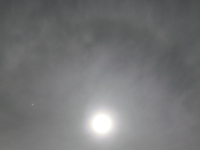 A 22 degree halo around the full moon. The bright "star" left of the moon, inside the halo, is actually the planet Mars, which is very close to opposition.
A 22 degree halo around the full moon. The bright "star" left of the moon, inside the halo, is actually the planet Mars, which is very close to opposition.
Below are some scans of (photographs of) slides of a really beautiful
halo apparition, observed in Death Valley (California) on a sunny
afternoon in October 1999. Many photographs have been taken with a
polarizing filter in front of the camera in order to suppress the blue
Rayleigh scattering from the air a little. The 22 degree halo is
visible, sundogs (parhelia) and also the circumzenithal arc are very well
visible in some photographs.
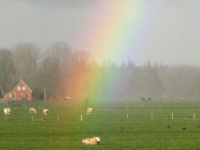 A relatively close rainbow, clearly in front of the distant trees.
A relatively close rainbow, clearly in front of the distant trees.
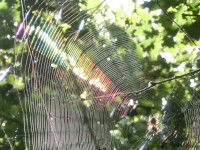 Diffraction of sunlight in a spider web, resulting in rainbow colours.
Diffraction of sunlight in a spider web, resulting in rainbow colours.
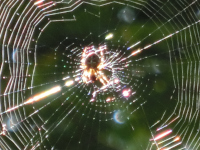 Slightly different angles of incident light and for observation, revealing rainbow colours around the spider as well.
Slightly different angles of incident light and for observation, revealing rainbow colours around the spider as well.
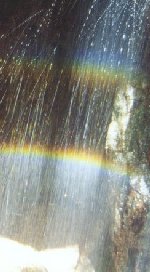 Although not really an atmospheric phenomenon in this case, the rainbow
photographed in this waterfall in the Alsace (northeastern France) clearly
shows that the region between the primary and secondary rainbow is
darker than the other regions.
Although not really an atmospheric phenomenon in this case, the rainbow
photographed in this waterfall in the Alsace (northeastern France) clearly
shows that the region between the primary and secondary rainbow is
darker than the other regions.
![]()